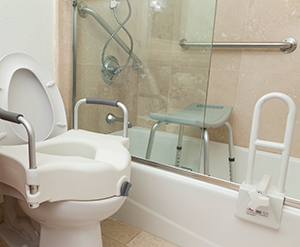Chronic Lung Disease, Day-to-Day Care: for Caregivers
Chronic Lung Disease, Day-to-Day Care: for Caregivers

Chronic lung disease may include COPD, which is chronic bronchitis and emphysema, pulmonary fibrosis, and sarcoidosis. With chronic lung disease, even getting in and out of bed can be difficult. Coping with the physical limits of these conditions can be a challenge for both your loved one and you. But you can each take steps to keep your daily routine simple.
Living healthier
Try to stay in good health. For example:
-
Encourage each other to stay active. Think of ways to be active together. You might go for a walk or do some gentle stretching exercises. Or try some chair exercises. For example, you can lift your legs up and down while sitting.
-
Physical therapy. Your loved one may benefit from physical therapy (PT). Talk with your healthcare provider about it.
-
Pulmonary rehab (rehabilitation). Look into programs in your area and encourage your loved one to participate. These programs help those with chronic lung conditions to better deal with their conditions and stay as active as possible.
-
-
Help each other plan and make meals.
-
Try to choose healthy foods. There are a lot of very unhealthy choices. But there are also healthier versions of most foods. There are low-fat, low-salt frozen dinners for example.
-
Your loved one may be limited. But think of ways he or she can help. For example, sitting at the table to cut vegetables.
-
-
Try to manage stress. Talk with your healthcare providers if you are having a hard time managing stress. Or if you are feeling depressed or anxious. You might try yoga, deep-breathing, or meditation. Learning to relax and to breathe more slowly can help both of you.
-
Get enough sleep. Both of you should try to get enough sleep each night. A short nap may be OK. But too much napping makes it harder to sleep at night. If symptoms are making it hard for your loved one to sleep, talk with his or her healthcare provider.
Making living spaces safe
Even a few changes can make your home safer. Try these tips:
-
Get help. Therapists can help you with home safety issues. Talk with your healthcare provider about home physical and occupational therapy.
-
In the bathroom, make changes to the shower or tub for safety. Get a waterproof stool and handheld water nozzle. Install grab bars to make getting in and out easier. Use only nonslip bath mats or rugs.
-
In the kitchen, make sure items that you use often are within reach. This includes dishes and silverware. Keep these items as close to counter height as possible. Bending or reaching for items can cause injuries to your loved one.
-
Make sure floors are safe all through the house. And remove small rugs to prevent tripping. Make sure all areas are well lit. Install grab bars and hand rails.
If you or your loved one smokes
Smoking makes symptoms worse and harms health. If either of you smokes, it’s time to stop. Speak with a healthcare provider or call the American Lung Association to learn about smoking cessation programs. Also try the following:
-
Make a list of reasons to quit. Keep the list handy and read it often.
-
List the places, feelings, and things that make you want to smoke. Think of ways to avoid them.
-
Think about what you can do instead of smoking. Again, make a list. Then use one of the items on the list if you want to smoke. For example, you might go for a walk, call a friend, or chew a piece of sugarless gum.
-
Ask your healthcare provider or pharmacist about medicines to help you stop smoking. Some are available over-the-counter and some only by prescription.
Updated:
September 04, 2019
Sources:
Diagnosis and Management of Stable Chronic Obstructive Pulmonary Disease: A Clinical Practice Guideline Update from the American College of Physicians, et al. Qaseem, A. Annals of Internal Medicine. 2011;155(3):s179-91.
Reviewed By:
Alan J Blaivas DO,John Hanrahan MD,Daphne Pierce-Smith RN MSN CCRC